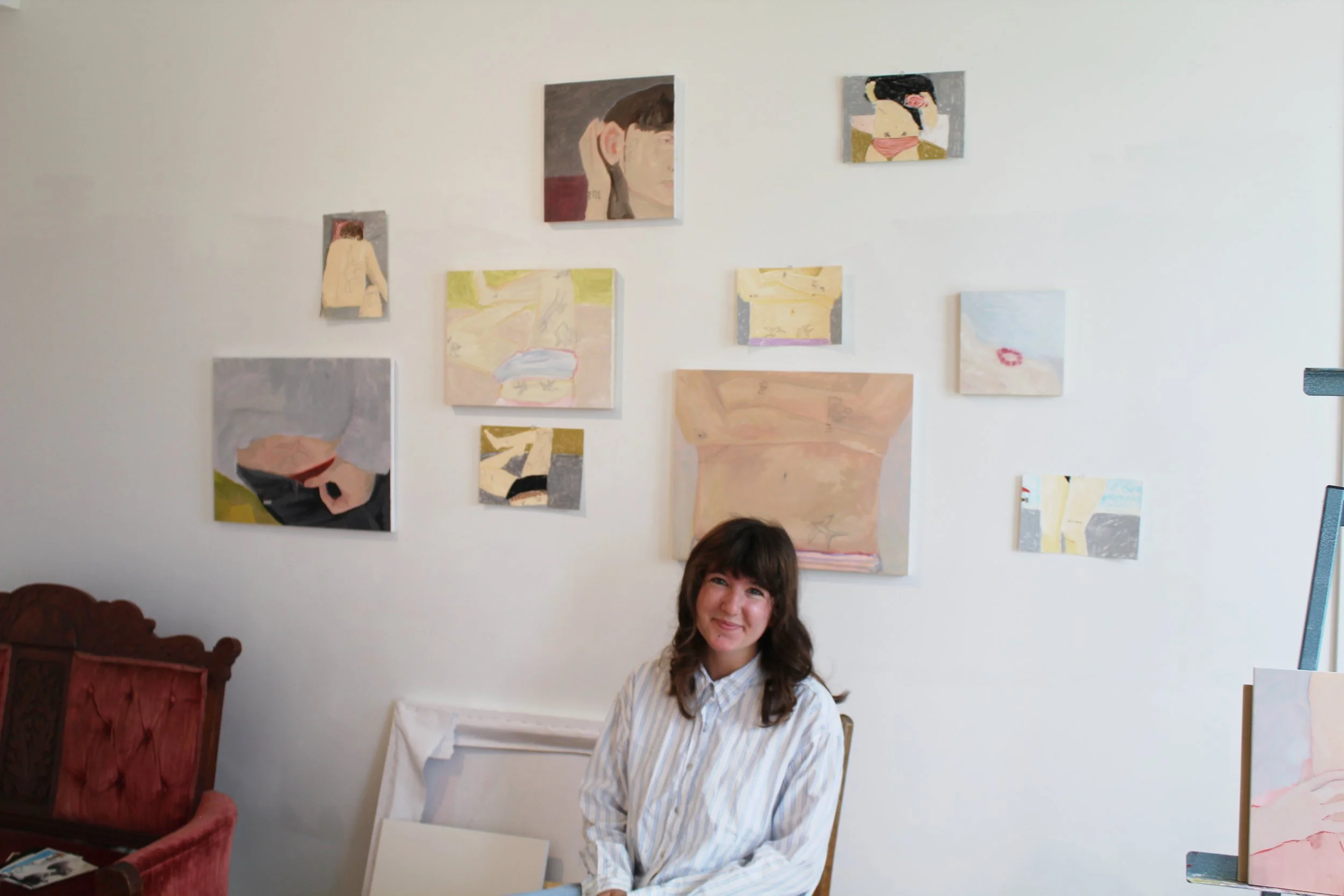Cam Clark: So, hi, Kate.
Kate Greenwell: Hi.
CC: What brings you here to Stove Works.
KG: I am a resident fellow, so basically I'll be here for six months instead of the normal one to three, like the typical residency. And I kind of am from Chattanooga, usually the resident fellow is. I graduated from the University of Tennessee with a BFA, so I get a studio while I'm here, and my main job is communication and scheduling between the residents, but it's also an opportunity for me to meet visiting artists while I'm moving into the next stage of my life after undergrad.
CC: It's good to see that you have so much work up. I'd like to talk a little bit about your collage practice,
KG: Of course, as you can see, just from sitting in my studio, I've got two different paths. But as I'm working on a lot of writing, I don't feel that they're as disconnected as they might look. So at Stove Works, I've kind of started two new projects, one of them is text and image based collage work, and the other one is a very large and fragmented self portrait of myself, highlighting all of my tattoos. Originally they weren't connected in my mind. I was just kind of going on two different paths, one collage based, one painting based. But as I began to work on them in the same space, I realized a lot of my work comes from seeking out symbols, text or images, and just kind of saying, Look at this, look at this and what it means, and that can exist in the sense of me, just taking that symbol, taking those words, and putting it into a new environment. For example, the tattoo pieces. They’re kind of like awkward, cartoony expressions of my own body highlighting areas that you wouldn't normally see. I'm giving a sense of intimacy in them, but I'm also just highlighting the words and symbols that are on my body that highlight where I am in life in a contemporary world where a lot of young people are doing tattoos piercings, but it's also just a nod to, like the amount of ephemera I have scattered on my body, and creates a map of myself through self portraiture.
Then completely on the other side of the other side of my practice, I've got these minimal collage works that I combine with text, and I am often deriving that text from the image archive. So in my studio I've got this giant library. I call it my archive, which is just books that I source my images from for my collages. And I'm very particular. People are always asking about content, but it's less about that, and it's more about the type of image. I'm very drawn to a specific paper type. It's like, it's aged black and white, kind of has a matte texture.
CC: kind of like a newsprint.
KG: Yeah, it's like newsprint material. I just think it reads really well on canvas, and I think it reads really well with letterpress. Letterpress being like an older medium, an older manual medium, that was normally done on newsprint. So I think those two crafts kind of speak to each other well. But yeah, my large image collection, I take the picture that I'm going to use for the collage piece, and I create a poem for it based on the original caption of the image.
CC: So the image informs the text?
KG: Yeah, the image informs the poem. For example, there’s this insane Hunter’s Digest book in front of me right now, but some of the captions are just incredible. Okay, so I’ll let you take a picture of this. But it reads: “Arthur shot this nice Montana mule deer after a long sneak that placed him directly above bedded buck on the rocky ledge.” Like, that’s kind of poetic.
CC: It's kind of poetic yeah.
KG: And the image is just gorgeous. It's jarring imagery, but at the same time, it's got that paper texture that I'm looking for that works so well on the matte linen. Yeah, I'll just let you take a picture of this, because it's an insane book. But, I let the book that the images come from influence the text directly. And usually I, actually, I do mount the original caption of the image onto the back of the collage piece, and I can show you that as well, but it's, it's like a hidden thing, and I it's either personal to myself because I know that it's on there, or I'll show somebody if they're in my studio, but it's something that's not meant to be seen, but I guess meant to be talked about.
CC: Is there anything that you would like to plug before we go?
KG: Yes, so basically there’s this gallery. During my time at Stove Works, I've been working on this curatorial project inspired by a lot of my friends that I made in January who work for a gallery called Wraymour and Flanigan, which is another DIY gallery, and they just inspired me to create a place inside of Stove Works. It’s called above the water fountain because it is above a water fountain. It’s a little alcove where I let artists that I’ve been in communication with whose practices are really important or inform my own practice exhibit. We do monthly exhibitions, solo shows where I highlight people that are important artists in the southeast, important to me, important to Stove Works, and just give them a place to showcase their work that they have in a smaller scale, and also an opportunity that is hard to find in a town where there's a lot of Gallery galleries, and this is more of a DIY creative space.
Instagram: @katesigridgreenwell
Website: katesigridgreenwell.com

